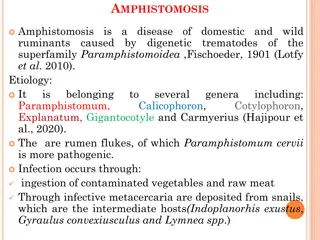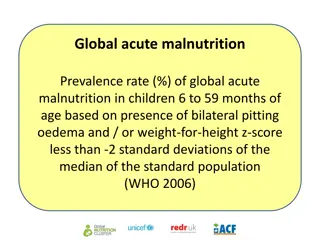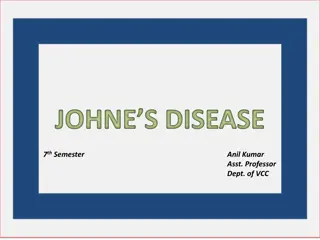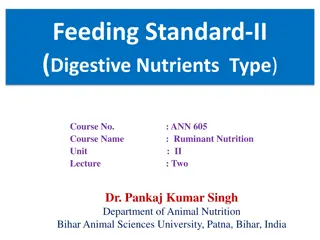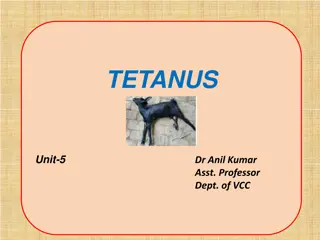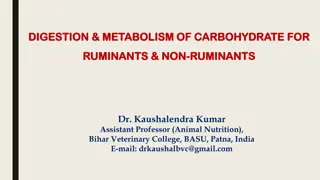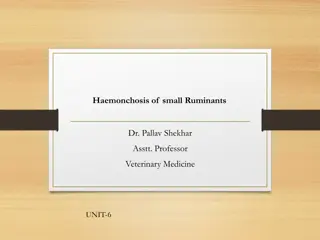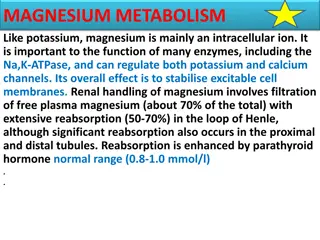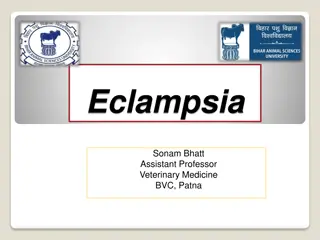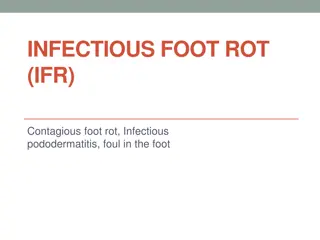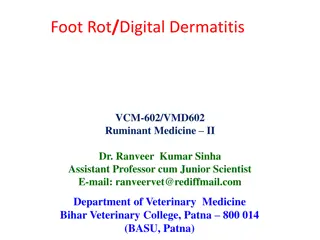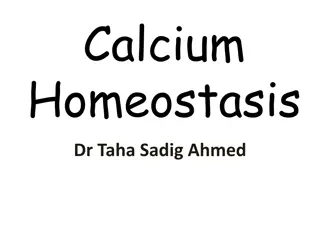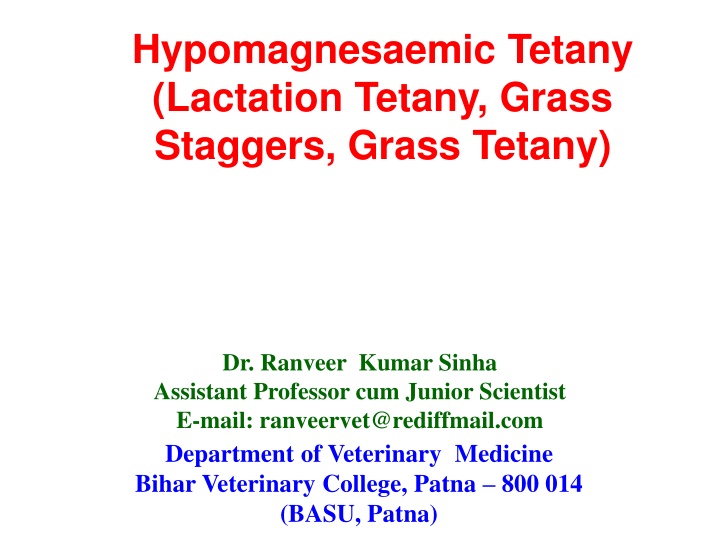
Hypomagnesaemic Tetany in Lactating Ruminants: Overview
Fatal metabolic disease affecting lactating ruminants, characterized by hyperesthesia, tetany, convulsions, and death. Factors contributing to its occurrence and clinical signs are discussed, along with insights into its etiology and pathogenesis.
Download Presentation

Please find below an Image/Link to download the presentation.
The content on the website is provided AS IS for your information and personal use only. It may not be sold, licensed, or shared on other websites without obtaining consent from the author. If you encounter any issues during the download, it is possible that the publisher has removed the file from their server.
You are allowed to download the files provided on this website for personal or commercial use, subject to the condition that they are used lawfully. All files are the property of their respective owners.
The content on the website is provided AS IS for your information and personal use only. It may not be sold, licensed, or shared on other websites without obtaining consent from the author.
E N D
Presentation Transcript
Hypomagnesaemic Tetany (Lactation Tetany, Grass Staggers, Grass Tetany) Dr. Ranveer Kumar Sinha Assistant Professor cum Junior Scientist E-mail: ranveervet@rediffmail.com Department of Veterinary Medicine Bihar Veterinary College, Patna 800 014 (BASU, Patna)
INTRODUCTION Highly fatal metabolic diseases of lactating ruminants, characterized clinically by hyperaesthesia, tetany, convulsions & death Incidence : (a)Species incidence : Cattle (sometimes sheep ) (b) Age incidence : 7-10 years old (5-8 Lactation) (c) Time incidence : 2-4 months after parturition
INTRODUCTION (B) Occurrence: (a) Lactating cattle grazing on lush pastures and green cereal crops ( High potassium levels decreases Mg absorption ). (b) Lactating cattle fed diet intoxicated with potassium fertilizers or urea (reduces availability of soil magnesium).
PREDISPOSING FACTORS (a) Starvation : 24-48 hours depress serum magnesium significantly. (b) Diarrhoea : Reduce magnesium absorption from intestines (c) Cold weather stress : Increase urinary excretion of magnesium. (d) Long transport: Depress serum magnesium and calcium.
ETIOLOGY AND PATHOGENESIS Basic biochemical finding in lactation tetany is hypomagnesaemia 0.5-1.5 mg/dL ( N 1.8 2.3mg/dL ). Mg is a co-factor for certain enzyme like Thiamine A decrease in Mg:Ca ratio will stimulate secretion of ACh esterase which is responsible for tetanic sign like hyperthesia, muscular tremor, convulsion etc.
CLINICAL SIGNS (A) Acute form: 1- Sudden onset of hyperaesthesia and muscle twitching 2- staggering in gait followed by falls down with tetany and convulsions. 3- During episodes (attack) there are: Opithotonus (back-head). Nystagmus (Rotation of eye ball). Champing of jaw. Frothing at from mouth.
CLINICAL SIGNS (A) Acute form Between episodes animal lie quiet but any noise or touch starting other attack . Pulse and respiration accelerated. Temperature moderately elevated (due to muscular spasm). Death from respiratory failure. B) Subacute form : Same signs of acute but onset gradual and course longer. (C) Chronic form : Animal have low serum magnesium but shows no symptoms.
DIAGNOSIS (C) Laboratory diagnosis: (a) Serum magnesium level (b) Low urine magnesium level. (c) Low CSF magnesium level. (d) Bone biopsy from ribs commonly revealed disturbed Ca: Mag. ratio. (D) Diagnostic therapy (Therapeutic diagnosis): Diseased animals respond well to calcium-magnesium therapy. Differential diagnosis BSE Rabies Encephalomyelitis Poisoning History: Clinical signs:
TREATMENT Contraindicated to use Mg compounds alone (may cause cardiac arrest). Safe therapy to use combined calcium- magnesium preparations as follow: 1- Calcium borogluconate 15% (I/V 500 ml). 2- Followed by: Magnesium lactate 15% (S/C 250 ml). 3- Followed by: Magnesium sulphate (oral 125 gram).
PREVENTION OF THE DISEASE 1- Magnesium supplementation of diet with crude magnesium 60 gm/head which can be mixed with molasses: 2- Magnesium Bullets placed in reticulum for slow liberation of constant traces of magnesium daily for long period as long as several months or even years.



